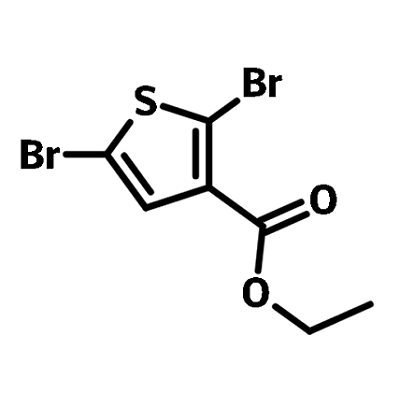Ethyl 2,5-dibromothiophene-3-carboxylate
CAS Number 289470-44-6
Chemistry Building Blocks, Dibromo Monomers, Heterocyclic Building Blocks, Materials, MonomersThiophene Building Block Functionalized with Bromides
For the synthesis of medium to low bandgap highly efficient polymer semiconductors
Specifications | MSDS | Literature and Reviews
Ethyl 2,5-dibromothiophene-3-carboxylate is a thiophene carboxylic acid derivatives. Carboxylate group is electron withdrawn to lower the electron density at the thiophene ring.
Ethyl 2,5-dibromothiophene-3-carboxylate has been used for the synthesis of medium to low bandgap highly efficient polymer semiconductors, i.e. PTQ2 and PBDB-TF-T1 (T1).
Thiophene building block
for the synthesis of OLED and organic photovoltaic materials
Worldwide shipping
Quick and reliable shipping
Functionalized with bromides
for facile reactions
High purity
>97% Purity
General Information
| CAS Number | 289470-44-6 |
| Chemical Formula | C7H6Br2O2 S |
| Molecular Weight | 314 g/mol |
| Full Name | Ethyl 2,5-dibromothiophene-3-carboxylate |
| Synonyms | 2,5-dibromo-3-ethylthiophene-carbon dioxide |
| Classification / Family | Thiophene derivatives, Organic semiconducting materials intermediates, Semiconductor Synthesis, Organic Photovoltaics |
Chemical Structure

Product Details
| Purity | 97% |
| Melting Point | 35 °C - 37 °C |
| Appearance | Yellow brownish powder/crystals |
MSDS Documentation
 Ethyl 2,5-dibromothiophene-3-carboxylate MSDS sheet
Ethyl 2,5-dibromothiophene-3-carboxylate MSDS sheet
Literature and Reviews
- Highly Efficient All-Polymer Solar Cells Enabled by Random Ternary Copolymer Acceptors with High Tolerance on Molar Ratios, Y. Wu et al., RRL Solar, 4 (11), 2000409 (2020); DOI: 10.1002/solr.202000409.
- Achieving Over 15% Efficiency in Organic Photovoltaic Cells via Copolymer Design, Y. Cui et al., Adv. Mater., 31 (14), 1808356 (2019); DOI: 10.1002/adma.201808356.
